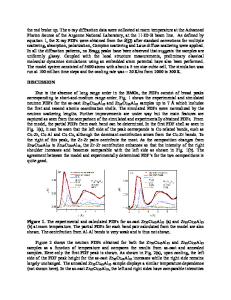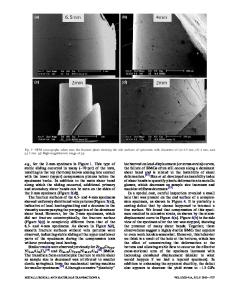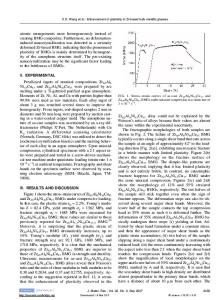Effects of plastic deformation and hydrogen charging on the internal friction in bulk and ribbon metallic glasses Zr 52.
- PDF / 487,921 Bytes
- 11 Pages / 585 x 783 pts Page_size
- 12 Downloads / 426 Views
H.-R. Sinning Institut für Werkstoffe, Technische Universität Braunschweig, 38106 Braunschweig, Germany
V.A. Khonik Department of General Physics, State Pedagogical University, Voronezh 394043, Russia
H. Neuhäuserb) Institut für Physik der Kondensierten Materie, Technische Universität Braunschweig, 38106 Braunschweig, Germany (Received 13 June 2006; accepted 13 October 2006)
Two different types of metallic glasses, a metal-metal-based and a metal-metalloidbased one, in both bulk and ribbon form (i.e., produced with very different quenching rates) are compared with respect to their structural relaxation behavior during continuous heating (2 K/min) in a vibrating-reed set-up (frequencies 0.2–5 kHz). The variation of damping as a function of temperature, time, and strain amplitude is shown as a measure of the content of structural relaxation centers, whose nature is studied by means of artificially introduced irregularities into the amorphous structure (i.e., by cold rolling and by hydrogen charging). The results indicate that the hydrogen damping peak, which is only observed in the Zr-based glass, is more probably due to hydrogen reorientation jumps than due to reorientation of hydrogen-related, dislocation-like distortion fields although the latter cannot be ruled out. A pronounced deformation damping peak could not be found in contrast to earlier results in the literature, probably owing to the selected degrees of deformation.
I. INTRODUCTION
Many attempts have been undertaken to characterize the metastable structure of metallic glasses1,2 and many experimental/simulation studies have shown their structural changes to occur by local atomic rearrangements into energetically more favorable configurations already upon slight heating. Such changes are commonly called “structural relaxation” and can be phenomenologically described as thermally activated processes distributed in a wide quasi-continuous spectrum of activation energies.3–8 The nature of structural relaxation centers, however, is still under discussion; many different pictures or models exist. For example, already early results on activation energies and attempt frequencies indicated that groups of atoms rather than single atoms are involved9,10,11; more a)
Present address: Institut für Werkstofftechnik, Universität Siegen, 57076 Siegen, Germany. b) Address all correspondence to this author. e-mail: [email protected] DOI: 10.1557/JMR.2007.0049 274
J. Mater. Res., Vol. 22, No. 2, Feb 2007
detailed configurations have been suggested by Khonik and coworkers (centers of “directional structural relaxation” including a two stage process7,8). According to the simulations of glassy structures, such local rearrangements are favored by fluctuations of local atom densities (“free volume”)12–15 and of local atomic stresses,16,17 and recent extensive computer simulations indicate correlated motion of neighboring atoms, often arranged in chains, during a relaxation event.18–20 Also creep and dynamic mechanical analysis investigations21,22 described by Kohlrausc
Data Loading...











